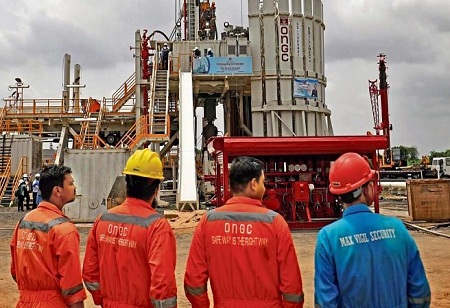ONGC, the largest oil and gas producer in India, will reverse years of production drop this year and progressively increase output going forward as it invests billions to produce from more recent discoveries. Oil and Natural Gas Corporation (ONGC) produced 21.707 million metric tonnes of crude oil in the fiscal year 2021–2022; this crude oil is refined to make petroleum products like gasoline and diesel; and 21.68 billion cubic metres (bcm) of natural gas, which is used to generate electricity, make fertiliser, and fuel compressed natural gas (CNG) vehicles.
ONGC Chairman Arun Kumar Singh, "We are absolutely looking forward to expanding production of oil and gas in 2023–24 and even in the current year." Production of gas and crude oil are expected to increase in the current fiscal year (2022-23) to 22.099 bcm and 22.823 million tonnes, respectively. Oil production will increase to 24.636 million tonnes in the following fiscal year
and to 25.689 million tonnes in 2024–25. The business is willing to collaborate in complex technical domains. ONGC is investing Rs 59,000 crore in 20 major projects, including the fourth phase rebuilding of the foundational Mumbai High fields and the bringing into production of oil and gas deposits discovered in deepsea KG block KG-DWN-98/2 (KG-D5). While spending on KG-D5 will increase output, reinvesting in Mumbai High and other fields that are currently producing would help slow the ageing fields' natural decline.
A floating production system (FPSO) and subsea facilities will soon be connected by the corporation. A peak gas output of 45,000 barrels per day (2.25 million tonnes annually) and roughly 12 million standard cubic metres per day of gas will occur in 2024–2025, with the first oil from KG–D5 anticipated in May 2023. In 2023–2024, the block is anticipated to produce 2.784 bcm of gas and 1.935 million tonnes of oil. According to Singh, ONGC would keep spending over Rs 30,000 crore on capital projects each year in an effort to stop the output decrease and then boost it.
The imposition of a windfall profit tax on locally produced crude oil will not have an impact on capital expenditures. The levy is activated at any price over and above USD 75 per barrel, a price that allows ONGC to continue investing in oil and gas exploration and production in the upcoming years. A little under 600 hydrocarbon finds have been made by the company. The majority of them were either in use or the process of making money off of them had already begun.
With the exception of around 42 finds that are remote, far from existing infrastructure, have extremely low volumes, or are situated in challenging locations, the roadmap for boosting output addresses the strategies for monetising all of ONGC's discoveries.
